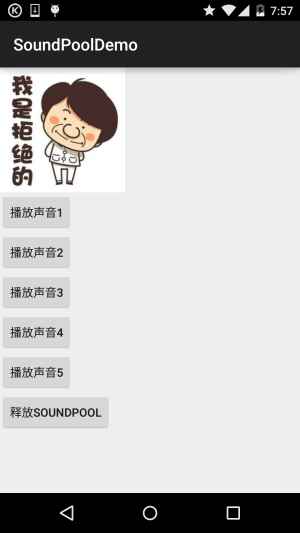本节引言:
1.相关方法介绍:
1)构造方法:
在低版本中可以用上述构造方法,而API 21(Android 5.0)后这个构造方法就过时了! 而用到一个SoundPool.Builder的东东,我们要实例化SoundPool只需调用:
SoundPool.Builder spb = new SoundPool.Builder(); spb.setMaxStreams(10); spb.setAudioAttributes(null); //转换音频格式 SoundPool sp = spb.build(); //创建SoundPool对象
要使用上述代码的话,TargetSDK版本要设置大于等于21哦!而且如果minSDK版本小于21 会出现下面的提醒:

2)常用方法介绍:
①加载声音资源:
参数介绍:
- context:上下文
- resId:资源id
- priority:没什么用的一个参数,建议设置为1,保持和未来的兼容性
- path:文件路径
- FileDescriptor:貌似是流吧,这个我也不知道
- AssetFileDescriptor:从asset目录读取某个资源文件,用法: AssetFileDescriptor descriptor = assetManager.openFd("biaobiao.mp3");
②播放控制:
参数依次是:
- soundID:Load()返回的声音ID号
- leftVolume:左声道音量设置
- rightVolume:右声道音量设置
- priority:指定播放声音的优先级,数值越高,优先级越大。
- loop:指定是否循环:-1表示无限循环,0表示不循环,其他值表示要重复播放的次数
- rate:指定播放速率:1.0的播放率可以使声音按照其原始频率,而2.0的播放速率,可以使声音按照其 原始频率的两倍播放。如果为0.5的播放率,则播放速率是原始频率的一半。播放速率的取值范围是0.5至2.0。
③资源释放:
3.使用代码示例:
运行效果图:

当点击按钮的时候会,"Duang"一下,这里演示了两种load的方法,分别是raw和assests!
关键代码:
MainActivity.java:
public class MainActivity extends AppCompatActivity implements View.OnClickListener{
private Button btn_play1;
private Button btn_play2;
private Button btn_play3;
private Button btn_play4;
private Button btn_play5;
private Button btn_release;
private AssetManager aManager;
private SoundPool mSoundPool = null;
private HashMap<Integer, Integer> soundID = new HashMap<Integer, Integer>();
@Override
protected void onCreate(Bundle savedInstanceState) {
super.onCreate(savedInstanceState);
setContentView(R.layout.activity_main);
aManager = getAssets();
try {
initSP();
} catch (Exception e) {
e.printStackTrace();
}
bindViews();
}
private void bindViews() {
btn_play1 = (Button) findViewById(R.id.btn_play1);
btn_play2 = (Button) findViewById(R.id.btn_play2);
btn_play3 = (Button) findViewById(R.id.btn_play3);
btn_play4 = (Button) findViewById(R.id.btn_play4);
btn_play5 = (Button) findViewById(R.id.btn_play5);
btn_release = (Button) findViewById(R.id.btn_release);
btn_play1.setOnClickListener(this);
btn_play2.setOnClickListener(this);
btn_play3.setOnClickListener(this);
btn_play4.setOnClickListener(this);
btn_play5.setOnClickListener(this);
btn_release.setOnClickListener(this);
}
private void initSP() throws Exception{
//设置最多可容纳5个音频流,音频的品质为5
mSoundPool = new SoundPool(5, AudioManager.STREAM_SYSTEM, 5);
soundID.put(1, mSoundPool.load(this, R.raw.duang, 1));
soundID.put(2 , mSoundPool.load(getAssets().openFd("biaobiao.mp3") , 1)); //需要捕获IO异常
soundID.put(3, mSoundPool.load(this, R.raw.duang, 1));
soundID.put(4, mSoundPool.load(this, R.raw.duang, 1));
soundID.put(5, mSoundPool.load(this, R.raw.duang, 1));
}
@Override
public void onClick(View v) {
switch (v.getId()){
case R.id.btn_play1:
mSoundPool.play(soundID.get(1), 1, 1, 0, 0, 1);
break;
case R.id.btn_play2:
mSoundPool.play(soundID.get(2), 1, 1, 0, 0, 1);
break;
case R.id.btn_play3:
mSoundPool.play(soundID.get(3), 1, 1, 0, 0, 1);
break;
case R.id.btn_play4:
mSoundPool.play(soundID.get(4), 1, 1, 0, 0, 1);
break;
case R.id.btn_play5:
mSoundPool.play(soundID.get(5), 1, 1, 0, 0, 1);
break;
case R.id.btn_release:
mSoundPool.release(); //回收SoundPool资源
break;
}
}
}
代码非常简单,另外如果你点击了最后一个按钮的话,SoundPool就会被释放,然后再其他按钮 就不会Duang了哦~
4.OnLoadCompleteListener监听声音文件是否加载完毕
mSoundPool.setOnLoadCompleteListener(new SoundPool.OnLoadCompleteListener() {
@Override
public void onLoadComplete(SoundPool soundPool, int sampleId, int status) {
Toast.makeText(MainActivity.this,"加特技准备完毕~",Toast.LENGTH_SHORT).show();
}
});
5.示例代码下载:
SoundPoolDemo.zip




